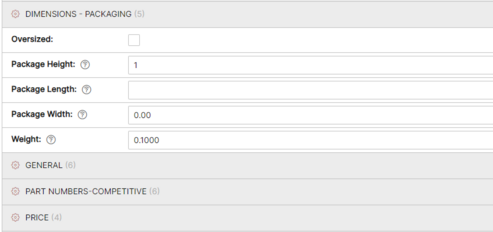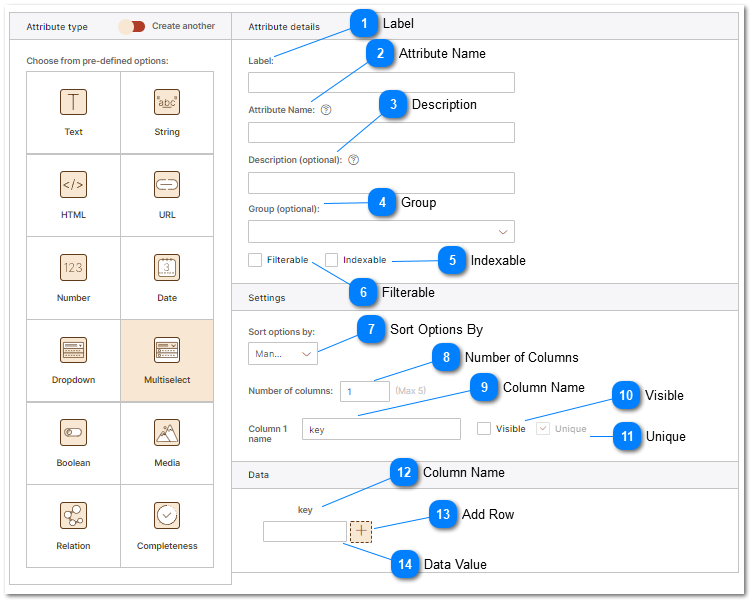PIM Dropdown Attribute Type
A dropdown attribute related to products in a Product Information Management System (PIM) refers to a type of attribute where the product information can be selected from a predefined list of options. These options are presented in a dropdown menu, hence the name.
Dropdown attributes are typically used when the information about a product falls within a specific set of defined values. This could be used, for example, to indicate the color of a product (with options like "red", "blue", "green"), the size of clothing (with options like "S", "M", "L", "XL"), or the material of an item (with options like "wood", "metal", "plastic").
This attribute type can help maintain consistency of data in the PIM by preventing free-text entries and ensuring the data entered aligns with the predefined options. Furthermore, they aid in product search and filtering, as they allow customers to select the exact specification they're looking for from the dropdown menu.
 LabelFriendly display name for the attribute displayed in the PIM editing user interface. Additionally labels are consumed by the brand portal and are visible to users who browse product data via the brand portal. |
|
 Attribute NameThe actual field name that the attribute is stored as in the Product Information Management System. This value will be used by end points and will be returned as the field name in channels and feeds unless otherwise mapped to a different field name using views. |
|
 DescriptionHelpful description of the purpose of the attribute stored in the PIM. Assists data entry personnel by proving information about what attribute data is stored in the PIM.
|
|
 GroupGroup provides multiple functions in the user interface, brand portals, connected channels, feeds and web sites. In the user interface Group allows attributes to be Grouped together for easy editing and display. The screenshot below demonstrates grouping of attributes with the "Group" Dimensions - Packaging" displayed for editing. All attributes that belong to the group are displayed together. Please refer to the Product Attribute Groups help topic for more information. For information on how groups are used by brand portals refer to the Brand Portals help topic.
|
|
 IndexableThe contents of the attribute can be indexed. Indexes are used for applying sort order and is different from the "Searchable" property which indexes data elements differently to allow searching on the contents of the attribute data. Indexing does not allow the ability to search.
|
|
 FilterableAttributes that are filterable may be used to filter products by attribute in Categories. For more information about filterable attributes see the help topic on Product Categories. |
|
 Sort Options ByProvides list sort order information to PIM editing interface and for use by external applications that use "Fast Data Serving" API endpoints. Proper list sorting provides a better data editor and eCommerce shopping and Brand Portal experience. |
|
 Number of ColumnsNumber of columns that will contain data in the dropdown list. Not all columns need to be visible to the end user. If the list will contain only color codes then the list would have only one column. If the list will contain color codes, color names along with a sort order then the list would contain three columns.
|
|
 Column NameThe name of each column in the list. The name should represent the data that will be contained in that column. In the screenshot above only one column has been defined ant that column's name has been set to "key."
|
|
 VisibleNot all columns need to be visible to the end user. Column visibility data is used in the Product Information Management System's user interface to define what the user will see. Visibility information is also sent along with product data to external systems connected to the PIM "Fast Data serving" API. In the case where color names and color codes are defined in a list, you may want the user to select the color by name and store the color code in the PIM. It would not be necessary to have the color code visible in this case.
|
|
 UniqueThis instructs the PIM to require that each data value in this column is unique for each of the rows in the drop down. No two rows can have the same value. This ensures that the values displayed in this column (or saved in the PIM in the case of a "key" field will clearly identify the appropriate selection made by the user or entered into the PIM.
|
|
 Column NameThe Column Name is displayed in the data editing area above each column.
|
|
 Add RowTo add multiple rows or records to the drop down click the add row button. All rows will be stored in the PIM and presented in the PIM user interface for selection while editing product data in the Product Information Management System. The data stored in the dropdown rows is also provided to external applications connected using the Product Information Management System's "Fast Data Serving" API
|
|
 Data ValueThe Data Value is where you type the value that will be stored in the specified column for each row or selection in the dropdown.
|
|



